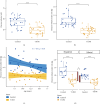Pancreas Imaging of Children with Type 1 Diabetes Reveals New Patterns and Correlations with Pancreatic Functions
- PMID: 40303255
- PMCID: PMC12017098
- DOI: 10.1155/2023/3295812
Pancreas Imaging of Children with Type 1 Diabetes Reveals New Patterns and Correlations with Pancreatic Functions
Abstract
Objective: To perform a longitudinal characterization of the pancreas in patients with new-onset T1D and investigate the correlations between magnetic resonance imaging (MRI) parameters and pancreatic functions during the first year postdiagnosis.
Methods: Thirty-one pediatric patients with new-onset T1D and 29 retrospective age-, body mass index-, and sex-matched controls were included in the study. Following hypotheses were investigated: (H1) the value of pancreas volume (PV) parameters in T1D and in controls, (H2) the association between MRI parameters and markers of pancreatic functions, (H3) the ability of MRI parameters to predict glucose homeostasis, (H4) the longitudinal evolution of MRI parameters and glucose homeostasis, per-organ (whole pancreas) and per-subregion (head, body, and tail).
Results: Patients with new-onset T1D demonstrated a significant decrease of PV at diagnosis compared to controls (-45%), with prepubertal patients having increased pancreas atrophy (+25%) (H1). PV parameters were correlated with C-peptide, and trypsinogen (PVTail and PVHead, respectively). Biparametric regression models including MRI parameters predicted pancreas functions during the first year postdiagnosis (H3). Longitudinal evolution of PV parameters at 1 year postdiagnosis was correlated with PV at diagnosis (R = -0.72) but not with markers of glucose homeostasis (H4).
Conclusion: Our study shows that longitudinal analysis of pancreases of children with T1D using multiparametric MRI improve the understanding of T1D heterogeneity both in the context of its onset and its evolution.
Copyright © 2023 Olivier G. Pollé et al.
Conflict of interest statement
The authors declare they have no conflicts of interest.
Figures




References
Publication types
MeSH terms
LinkOut - more resources
Full Text Sources
Medical

